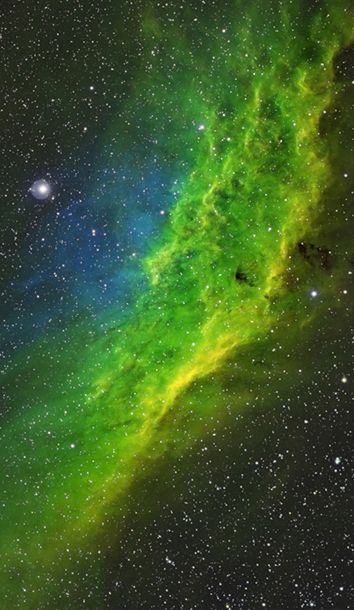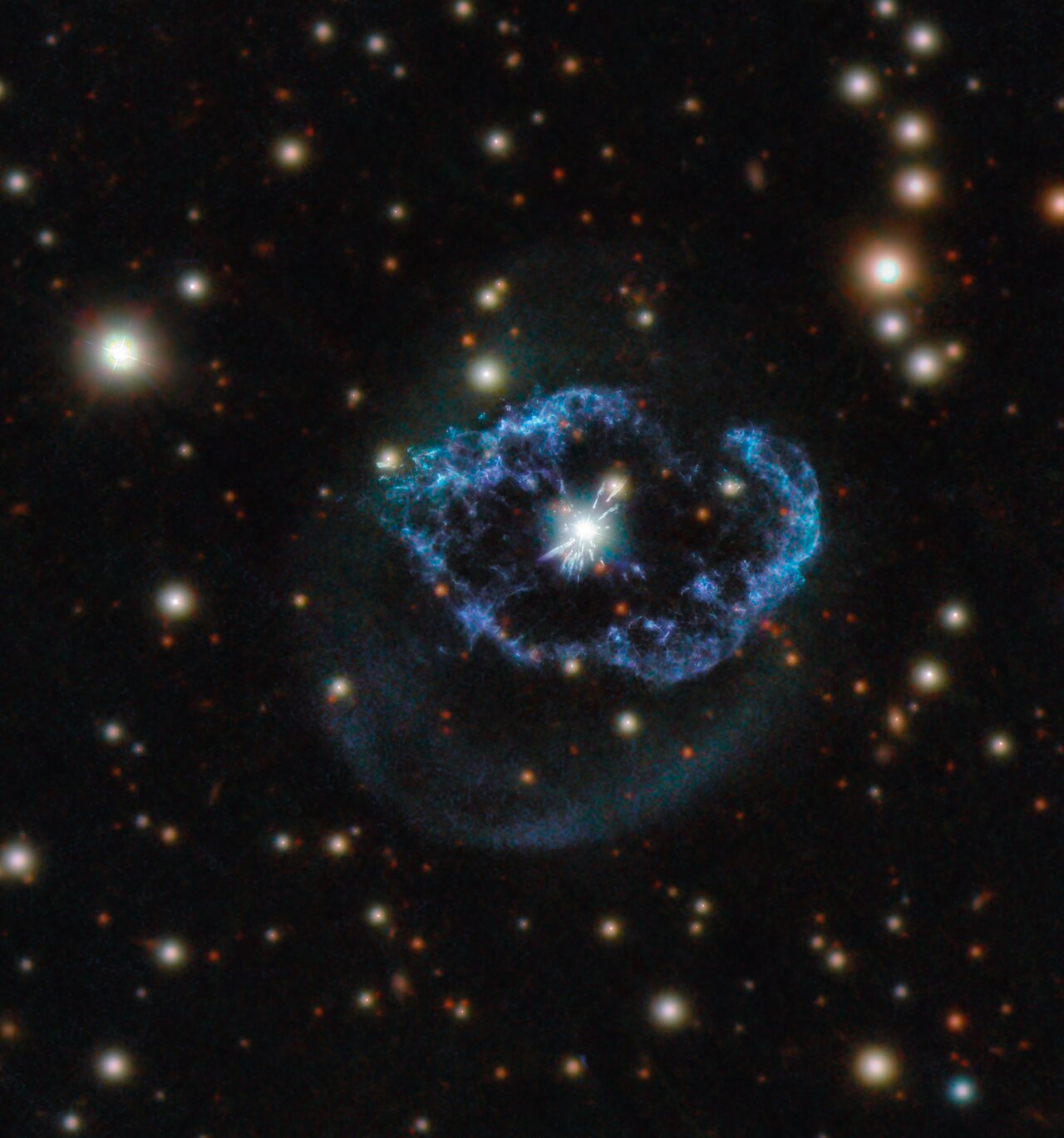The California Nebula (NGC 1499) is an emission nebula located in the constellation Perseus. It is so named because it appears to resemble the outline of the US State of California on long exposure photographs. It is almost 2.5° long on the sky and, because of its very low surface brightness, it is extremely difficult to observe visually. It can be observed with a Hα filter (isolates the Hα line at 656 nm) or Hβ filter (isolates the Hβ line at 486 nm) in a rich-field telescope under dark skies. It lies at a distance of about 1,000 light years from Earth.

John Benson Sebastian (born March 17, 1944) is an American singer/songwriter, guitarist, harmonicist, and autoharpist. He is best known as a founder of The Lovin’ Spoonful, as well as his impromptu appearance at the Woodstock festival in 1969 and a US No. 1 hit in 1976, “Welcome Back.” The Lovin’ Spoonful was inducted into the Rock and Roll Hall of Fame in 2000. olk-rock and pop with elements of blues, country, and jug band music, became part of the American response to the British Invasion, and was noted for such hits as “Do You Believe in Magic“, “Summer in the City“, “Daydream“, “Did You Ever Have to Make Up Your Mind?“, “You Didn’t Have to Be So Nice“, “Darling Be Home Soon“, “Jug Band Music”, “Rain on the Roof”, “Nashville Cats”, and “Six O’Clock”
https://www.youtube.com/watch?v=rts7Qdew3HE
see full post...Paul Horn (March 17, 1930 – June 29, 2014) was an American flautist, saxophonist, composer and producer. He became a pioneer of world and new age music with his 1969 album Inside.
Horn was born on March 17, 1930 in New York City and has Jewish roots through his father. The family moved to Washington, D.C. when Horn was four. He took up the piano at age four, followed by the clarinet at 12. While in Washington, D.C., Horn attended Theodore Roosevelt High Schooland the Washington College of Music. In the summer of 1942, Horn worked as an usher at the Earl Theatre to buy a clarinet. He studied the clarinet and flute at the Oberlin Conservatory of Music in Ohio, earning a bachelor’s degree. In June 1953, Horn gained a master’s from the Manhattan School of Music.
Moving to Los Angeles he played with Chico Hamilton‘s quintet from 1956 to 1958 and became an established West Coast session player. He played on the Duke Ellington Orchestra’s Suite Thursday and worked with Nat King Cole, Tony Bennett and others. He scored the 1959 animated television series Clutch Cargo.
In 1960 Horn recorded for Fantasy Records with Latin Jazz vibraphonist Cal Tjader (with drummers Willie Bobo and Mongo Santamaria) for the album Latino! (originally released in 1962 and later re-released with the same title in 1992). He appears playing with his band in the opening scene at the jazz club in Curtis Harrington‘s film Night Tide.
Horn’s Quintet produced jazz albums for Columbia and RCA Victor up until 1966. During this period, he was the subject of a David Wolper television documentary Portrait of a Jazz Musician.
Horn became a practitioner of transcendental meditation. He attended training at the Maharishi Mahesh Yogi‘s ashram along with The Beatles on their 1968 trip to India. Following his experiences in India, Horn’s recordings moved from jazz to world and new-age music.
see full post...Nathaniel Adams Coles (March 17, 1919 – February 15, 1965), known professionally as Nat King Cole, was an American singer and jazz pianist. He recorded over 100 songs that became hits on the pop charts. His trio was the model for small jazz ensembles that followed. Cole also acted in films and on television and performed on Broadway. He was the first African-American man to host an American television series. He was the father of singer-songwriter Natalie Cole (1950–2015).
Nathaniel Adams Coles was born in Montgomery, Alabama, on March 17, 1919. He had three brothers: Eddie (1910–1970), Ike (1927–2001), and Freddy (1931–2020), and a half-sister, Joyce Coles. Each of the Cole brothers pursued careers in music. When Nat King Cole was four years old, the family moved to Chicago, Illinois, where his father, Edward Coles, became a Baptist minister. In September 1964, Cole began to lose weight and he experienced back problems. He collapsed with pain after performing at the Sands Hotel in Las Vegas. In December, he was working in San Francisco when he was finally persuaded by friends to seek medical help. A malignant tumor in an advanced state of growth on his left lung was observed on a chest X-ray. Cole, who had been a heavy cigarette smoker, had lung cancer and was expected to have only months to live. Against his doctors’ wishes, Cole carried on his work and made his final recordings between December 1 and 3 in San Francisco, with an orchestra conducted by Ralph Carmichael. The music was released on the album L-O-V-E shortly before his death. His daughter noted later that he did this to assure the welfare of his family. On Valentine’s Day, Cole and his wife briefly left St. John’s to drive by the sea. He died at the hospital early in the morning of February 15, 1965.
see full post...Lovie Lee (March 17, 1909 – May 23, 1997) was an American electric blues pianist and singer. He is best known for his work accompanying Muddy Waters. He also recorded a solo album, in 1992. He was the “adoptive stepfather” of the bluesman Carey Bell and thus the “grandfather” of Lurrie Bell.
He was born Edward Lee Watson in Chattanooga, Tennessee, and grew up in Meridian, Mississippi. He taught himself to play the piano and began performing in various churches and at rodeos and vaudeville shows. He had already acquired the nickname Lovie from a doting aunt. He found part-time employment playing with the Swinging Cats in the early 1950s. The group included Carey Bell, who Lee took under his “fatherly” protection, and together they moved to Chicago, in September 1956. Lee worked during the day in a woodworking factory, and for many years played in the evening in numerous Chicago blues nightclubs, including Porter’s Lounge. He was well known around Chicago for his blues piano playing. He later worked as an upholsterer, but he kept together his backing band, the Sensationals.
see full post...In the constellation of the swan near the nebula of the pelican lies the gas cloud of the butterfly next to a star known as the hen. That star, given the proper name Sadr, is just to the right of the featured frame, but the central Butterfly Nebula, designated IC 1318, is shown in high resolution. The intricate patterns in the bright gas and dark dust are caused by complex interactions between interstellar winds, radiation pressures, magnetic fields, and gravity. The featured telescopic view captures IC 1318‘s characteristic emission from ionized sulfur, hydrogen, and oxygen atoms mapped to the red, green, and blue hues of the popular Hubble Palette. The portion of the Butterfly Nebula pictured spans about 100 light years and lies about 4000 light years away.

Frederick Neil (March 16, 1936 – July 7, 2001) was an American folk singer-songwriter active in the 1960s and early 1970s. He did not achieve commercial success as a performer and is mainly known through other people’s recordings of his material – particularly “Everybody’s Talkin’“, which became a hit for Harry Nilsson after it was used in the film Midnight Cowboy in 1969. Though highly regarded by contemporary folk singers, he was reluctant to tour and spent much of the last 30 years of his life assisting with the preservation of dolphins.
Born in Cleveland, Ohio, and raised in St. Petersburg, Florida, Neil was exposed to music at an early age, travelling around the US with his father, who was a representative for Wurlitzer jukeboxes. Neil was one of the singer-songwriters who worked out of New York City’s Brill Building, a center for music industry offices and professional songwriters. While composing at the Brill Building for other artists, Neil also recorded six mostly rockabilly-pop singles for different labels as a solo artist. He wrote songs that were recorded by early rock and roll artists such as Buddy Holly (“Come Back Baby” 1958) and Roy Orbison (“Candy Man” 1961).
see full post...Minoru Miki (三木 稔 Miki Minoru; 16 March 1930 – 8 December 2011) was a Japanese composer and artistic director, particularly known for his promotional activities in favor of Japanese (as well as Chinese and Korean) traditional instruments and some of their performers.
His vast catalogue, where aforementioned traditional instruments figure profusely either solo or in various types of ensemble with or without Western instruments, demonstrates large stylistic and formal diversity. It includes operas and several types of stage music as well as orchestral, concerto, chamber and solo music, and music for films. Miki was probably the second best known Japanese composer overseas after Tōru Takemitsu. He was a pioneer in the composition of contemporary classical music for large ensembles of traditional Japanese musical instruments. In 1964 he founded the Nihon Ongaku Shūdan (Pro Musica Nipponia ensemble), also known as Ensemble Nipponia, for which he has composed extensively.
see full post...Thomas Lee Flanagan (March 16, 1930 – November 16, 2001) was an American jazz pianist and composer. He grew up in Detroit, initially influenced by such pianists as Art Tatum, Teddy Wilson, and Nat King Cole, and then by the newer bebop musicians. Within months of moving to New York in 1956, he had recorded with Miles Davis and on Sonny Rollins‘ landmark Saxophone Colossus. Recordings under various leaders, including the historically important Giant Steps of John Coltrane, and The Incredible Jazz Guitar of Wes Montgomery, continued well into 1962, when he became vocalist Ella Fitzgerald‘s full-time accompanist. He worked with Fitzgerald for three years until 1965, and then in 1968 returned to be her pianist and musical director, this time for a decade.
After leaving Fitzgerald in 1978, Flanagan then attracted praise for the elegance of his playing, which was principally in trio settings when under his own leadership. In his 45-year recording career, he recorded more than three dozen albums under his own name and more than 200 as a sideman. By the time of his death, he was one of the most widely admired jazz pianists and had influenced both his contemporaries and later generations of players.
Flanagan was born in Conant Gardens, Detroit, Michigan, on March 16, 1930. He was the youngest of six children – five boys and a girl. His parents were both originally from Georgia. His father, Johnson Sr, was a postman, and his mother, Ida Mae, worked in the garment industry.
At the age of six, Flanagan’s parents gave him a clarinet for Christmas. He learned to read music from playing the clarinet, but within a few years he preferred the piano. The family had a piano in the house, and Flanagan received lessons from one of his brothers, Johnson, and Gladys Wade Dillard, who also taught Kirk Lightsey and Barry Harris. Flanagan graduated from Northern High School, which he attended with other future musicians, including saxophonist Sonny Red.
https://www.youtube.com/watch?v=_0lY3JuyN7k
see full post...Abraham John Bond Jr., known as Son Bonds (March 16, 1909 – August 31, 1947), was an American country blues guitarist, singer and songwriter. He was a working associate of Sleepy John Estes and Hammie Nixon. He was similar to Estes in his guitar-playing style. According to the music journalist Jim O’Neal, “the music to one of Bonds’s songs, ‘Back and Side Blues’ (1934), became a standard blues melody when Sonny Boy Williamson I, from nearby Jackson, Tennessee, used it in his classic “Good Morning, School Girl“. The best-known of Bonds’s other works are “A Hard Pill to Swallow” and “Come Back Home.”
Bonds was born in Brownsville, Tennessee. He was also billed on records as “Brownsville” Son Bonds and Brother Son Bonds.
Sleepy John Estes, in his earlier recordings, was backed by Yank Rachell (mandolin) or Hammie Nixon (harmonica), but by the late 1930s he was accompanied in the recording studio by either Bonds or Charlie Pickett (guitar). Bonds also backed Estes on a couple of recording sessions in 1941. In return, either Estes or Nixon played on every one of Bonds’s own recordings. In the latter part of his career, Bonds played the kazoo as well as the guitar on several tracks.
see full post...https://www.youtube.com/watch?v=_hvlUqdkeHI
see full post...Located around 5000 light-years away in the constellation of Cygnus (The Swan), Abell 78 is an unusual type of planetary nebula. After exhausting the nuclear fuel in their cores, stars with a mass of around 0.8 to 8 times the mass of our Sun collapse to form dense and hot white dwarf stars. As this process occurs, the dying star will throw off its outer layers of material, forming an elaborate cloud of gas and dust known as a planetary nebula. This phenomenon is not uncommon, and planetary nebulae are a popular focus for astrophotographers because of their often beautiful and complex shapes. However, a few like Abell 78 are the result of a so-called “born again” star. Although the core of the star has stopped burning hydrogen and helium, a thermonuclear runaway at its surface ejects material at high speeds. This ejecta shocks and sweeps up the material of the old nebula, producing the filaments and irregular shell around the central star seen in this Picture of the Week, which features data from Hubble’s Wide Field Camera 3 and PANSTARSS.

Ryland Peter Cooder (born March 15, 1947 LA, CA) is an American musician, songwriter, film score composer and record producer. He is a multi-instrumentalist but is best known for his slide guitar work, his interest in roots music from the United States, and his collaborations with traditional musicians from many countries.
Cooder’s solo work draws upon many genres. He has played with John Lee Hooker, Captain Beefheart, Gordon Lightfoot, Ali Farka Touré, Eric Clapton, The Rolling Stones, Van Morrison, Neil Young, Randy Newman, Linda Ronstadt, Vishwa Mohan Bhatt, David Lindley, The Chieftains, The Doobie Brothers, and Carla Olson & the Textones (on record and film). He formed the band Little Village. He also produced the Buena Vista Social Club album (1997), which became a worldwide hit. Wim Wenders directed the documentary film of the same name (1999), which was nominated for an Academy Award in 2000.
Cooder was ranked eighth on Rolling Stone magazine’s 2003 list of “The 100 Greatest Guitarists of All Time” (David Fricke’s Picks). A 2010 ranking by Gibson placed him at number 32.
see full post...Sylvester Stewart (born March 15, 1943), better known by his stage name Sly Stone, is an American musician, songwriter, and record producer who is most famous for his role as frontman for Sly and the Family Stone, playing a critical role in the development of funk with his pioneering fusion of soul, rock, psychedelia, and gospel in the 1960s and 1970s.
Raised in California, Stone mastered several instruments at an early age and performed gospel music as a child with siblings (and future bandmates) Freddie and Rose. In the mid-1960s, he worked as both a record producer for Autumn Records and a disc jockey for San Francisco radio station KSOL. In 1966, Stone formed Sly & the Family Stone, among the first racially integrated, male and female acts in popular music. The group would score hits such as “Dance to the Music” (1968), “Everyday People” (1968), “Thank You (Falettinme Be Mice Elf Agin)” (1969) and “Family Affair” (1971) and acclaimed albums such as Stand! (1969) and There’s a Riot Goin’ On (1971).
By the mid-1970s, Stone’s drug problems and erratic behavior effectively ended the group, leaving him to record several unsuccessful solo albums. In 1993, he was inducted into the Rock and Roll Hall of Fame as a member of the group. He took part in a Sly and the Family Stone tribute at the 2006 Grammy Awards, his first live performance since 1987.
see full post...